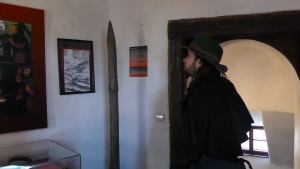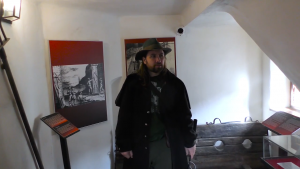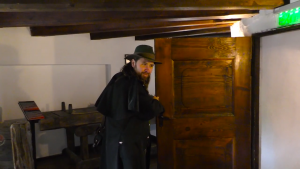
The Torture Exhibition
A blog post by Greg
As you can probably tell from the title, this post may, I fear, get a little dark. I can fully understand if you choose to give this one a pass (although I will avoid going into too many details about the torture methods). The reason that I can understand this the most is because we nearly made the same choice with the exhibitions.
When we arrived at Bran Castle as the first castle in our ‘Romania: Seeking Dracula’s Castle’ video, which you can watch using the links at the end of this post, we saw a sign for the ‘Torture Exhibition’, a display of torture implements which had a small extra charge.
This led to a discussion. We were here outside of a beautiful castle in the sunshine, and we were ready to enjoy exploring it. We had already been in the castle grounds that morning flying our drone for the first time in one of our travel adventure videos, and had managed to get some amazing shots. All in all we were in high spirits.
When we saw the signs for the torture display, my first instinct was to give it a miss. I knew enough of the history of torture that I felt I was unlikely to learn anything useful, and as a general rule I would have little interest in looking around a display showing some of the ways that the human imagination has been used to create tools and machines built purely for the purpose of causing as much pain as possible to another person. That is not to say we don’t enjoy visiting somewhat creepy or macabre places on our travels sometimes, but torture devices are not something which I would normally feel the need to see.
Felicity pointed out, however, that a major part of our goal here in Romania was to try to find the castle of Vlad the Impaler, and, in so doing, to try to reach an understanding of the man and the legend which surrounds him. Part of his story involves torture. Most famously he used the method of impaling people on wooden spikes, but it is suggested that while he was held as a hostage of Murad ll, the Ottoman ruler, as a young man, that he may have been ‘trained’ in various methods of torture, methods which, according to many people, he would not have been squeamish about using when he thought it necessary.
We reached the decision that on this occasion we should go into the torture exhibition, so that as we visited the beautiful castles and locations in our search for Vlad Dracula, we would also have forefront in our minds some of the horrors which he enacted in his reigns.

Immediately on entering we saw an Iron Maiden. This object I was most familiar with from what is possibly one of the most famous moments from the ‘Paul Daniels Magic Show’, where he ended an episode with an escape apparently going wrong with him slammed inside – which may sound quite tame for a television magic show these days, but back then sparked complaints and required him to return later in the evening’s schedule to announce that he was alright.
As this item was fixed in my mind as part of a magic trick, my brain didn’t immediately link in to its original purpose, and I couldn’t help making a ‘Two Tickets To Iron Maiden’ joke based on the song by Wheatus (a fact I include as it is one of the few semi-modern, almost-popular music references I know).
The mood changed almost immediately, however, as we turned around to face a chair completely covered in wooden spikes.
The purpose and use of this chair, known as an ‘Interrogation Chair’ or a ‘Witches’ Chair’ was immediately obvious, and immediately drained any levity from the air. This was an implement which had clearly not only been carefully designed by somebody, but would also have been intricately crafted, each one of the spikes individually made by hand. Several people would probably have been involved in the making of this chair, from the design, to the wood-crafting and the metal work, and they would all have known the purpose of what they were creating. Added to that you would have needed at least two people to restrain the person being placed in the chair (lest we forget that those accused of ‘witchcraft’ were usually innocent of any crime), and someone to sanction the punishment or interrogation (unlike Vlad, most rulers or heads of ‘justice’ would not get their hands dirty themselves), and you have a good half a dozen who needed to be involved in order for this chair to come into being and be used. Added to that a society which allowed such things to happen, and this single object becomes a poignant symbol of the evils of torture.
I don’t feel the need to go any further into describing any of the apparatus on display. The exhibition itself was well put together. As you walked through multiple rooms, seeing dozens of devices from the simple to the complex, it was quite sparsely laid out. The castle rooms were the perfect setting for such a display, they felt like rooms which the devices fitted into, rooms where you would not be surprised to hear devices like these had once been used. Most of the devices were accompanied by a short explanation of their use, and sometimes examples of when or where they had been used. Many of them had old fashioned ‘woodcut’ style images of the devices being used (similar to the illustration we used to show the impaling during the ‘Vlad Dracula’ introduction section of our video).
As we went around, and moved from room to room, it seemed an endless display of devices. In the final room we came face to face with a wooden spike (pictured at the top of this post), used for impaling. Of all of the intricate mechanical devices on display in the exhibition, I don’t think any made me feel as cold, disgusted or sad as this item as, owing to our research into Vlad the Impaler, it was the one whose use I was most familiar with. Having seen it, we had, I felt, fulfilled our duty to the video we were making, and could get out of the torture exhibitions. At that point in time I just wanted to get out into ‘fresh air’.

On the way out of the exhibition we went through a squeaky door, which amused me (partly I think this was enhanced by the joy of leaving the oppressive atmosphere created by the devices), and started to bring us out of the melancholy of seeing all of the equipment and images in the room – a lighter moment as we sought to bring ourselves out of the darkness of the torture exhibition so that we could get back to filming with a lighter tone through the rest of our visit at Bran Castle. For eagle-eyed viewers of the travel video, you will notice that in the edit we decided to separate out the ‘squeaky door’ from the ‘torture exhibition’ sections of the film, because we felt the tone of the two pieces didn’t fit in the final edit – yes, occasionally we do make minor tweaks to the order of events when it is necessary to keep the pace or tone of the video!
Which brings me to the end of this post. Like our decision to visit the exhibition in the first place, my decision to write this blog was back and forth to start with, but I eventually reached the same decision we made outside Bran Castle. This blog series, the same as our ‘Romania: Seeking Dracula’s Castle’ video, would have felt incomplete without it being included.
If I went back to Bran Castle, would I go back into the ‘Torture Exhibition’ again? I don’t think I would, not unless we were going back to film something which made that room necessary to include. It is a very well put together exhibition – it lacked the gory ‘waxworks’ style models which I have seen in some museums which feature one or two torture instruments, and which I personally find makes them both more graphic and at the same time less poignant. Nothing competes with seeing the objects, reading a description of what they were used for and how they worked, and then trying to stop your brain conjuring up the images. So as the exhibition it was, it was done very tastefully, very informative and very well put together. I would recommend it if it is something which you think you would be interested in seeing, but if I were visiting the castle purely on holiday, I would have passed it by.
Next time I write a post, much like the squeaky door, I will be writing on a much happier, much funnier, and much lighter subject.
Thanks for reading, and please take unbelievably good care of yourselves and of each other.
Greg
P.S.
If you enjoyed this blog post, please leave a comment and say ‘hello’!
For information on all of our projects, visit: www.gregandfelicityadventures.com
Follow us on Instagram at: https://www.instagram.com/gregandfelicity
Like us on Facebook at: https://www.facebook.com/GregandFelicityAdventures
There are various places you can watch our documentaries and series!
Seeking Cetaceans In Scotland: A two-part documentary about the work of the Cetacean Research and Rescue Unit as they work to help whales, dolphins and porpoises in the Moray Firth in Scotland:
Free in the USA on Tubi TV at:
https://tubitv.com/movies/678018/seeking-cetaceans-in-scotland
Free Worldwide on PlexTV at:
https://watch.plex.tv/movie/seeking-cetaceans-in-scotland
With a library card on the Hoopla service where applicable:
https://www.hoopladigital.com/title/15313766
Free in the USA on Xumo at:
https://www.xumo.tv/channel/99991731/free-documentaries?v=XM00ILOFXCKLUC&p=74071
Buy it without ads Amazon’s Prime Video at:
UK: https://www.amazon.co.uk/dp/B09RVWVFCV
USA: https://www.amazon.com/dp/B09RVWJGY1
(Greg and Felicity are donating half of our streaming income on this documentary to support the CRRU).
Available to buy on DVD (with £5 from each donated to the charity): https://ko-fi.com/s/73e469d114
ROMANIA: SEEKING DRACULA’S CASTLE: Our travel documentary looking into the history, legend and castles connected to Vlad Dracula III, sometimes known as Vlad the Impaler, and a journey around Romania:
Free Worldwide on Plex: https://watch.plex.tv/movie/romania-seeking-draculas-castle
Free (USA) on Tubi: https://tubitv.com/movies/579192/romania-seeking-dracula-s-castle
Prime Video (From £1.99, no Ads) (UK): https://www.amazon.co.uk//dp/B08RDPZP14
Prime Video (From $1.99, no Ads) (USA): https://www.amazon.com/dp/B08RDJR4F2
TURKEY: FAIRY CHIMNEYS AND UNDERGROUND CITIES: A travel documentary across Turkey, from the Fairy Chimneys and Underground Cities of Cappadocia to the ancient Greek ruins of Ephesus and Hierapolis:
Prime Video UK (From £2.49, no Ads): https://www.amazon.co.uk/Turkey-Fairy-Chimneys-Underground-Cities/dp/B09KKSZLRW
Prime Video USA (From $1.99, no Ads): https://www.amazon.com/Turkey-Fairy-Chimneys-Underground-Cities/dp/B09KK6VDJB
Free Worldwide on Plex: https://watch.plex.tv/movie/turkey-fairy-chimneys-and-underground-cities
Free (USA) on Tubi: https://tubitv.com/movies/579225/turkey-fairy-chimneys-and-underground-cities
Greg Chapman’s Magic Show: An eight-part series of magic and entertainment with Greg:
Free in the USA on Tubi at: https://tubitv.com/series/300008713/greg-chapman-s-magic-show
Free worldwide on Plex: https://watch.plex.tv/show/greg-chapmans-magic-show/season/1
Available to buy on DVD: https://ko-fi.com/s/7c1bc10a08
Mexico: Mayan Mystery and Marine Majesty: Filmed on our honeymoon in Mexico in 2019, our first travel documentary took us through the ancient sites of Teotihuacan, Uxmal, El Tajin, Palenque, Chichen Itza and Calakmul, and then on to see the whales of Magdalena Bay, whale sharks of La Paz, and more.
Watch free on YouTube: https://youtu.be/yfMpD868MHU
The Isle of Man: Railways, Castles and Seals: Our second travel documentary took us to the Isle of Man!
Watch free on YouTube: https://youtu.be/uCpUa6XEkbg